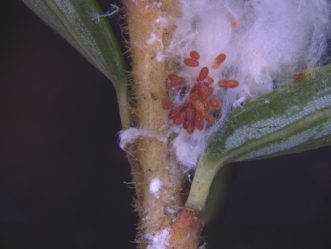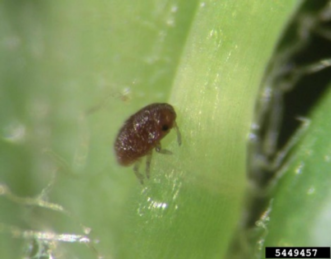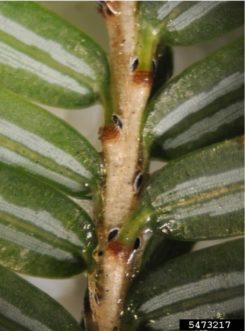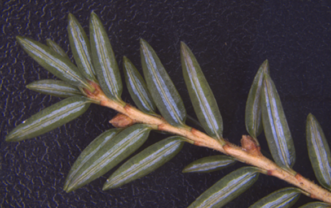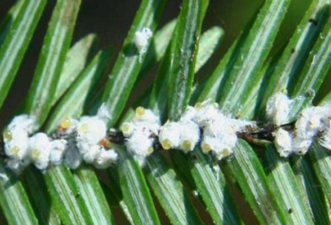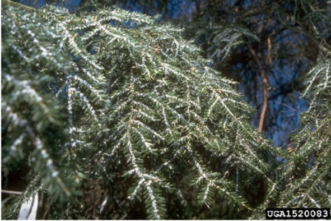Hemlock woolly adelgid (Adelges tsugae, HWA) is an aphid-like invasive pest of hemlock trees in eastern North America. The HWA is native to all hemlock species in western North America and Asia, and hemlock trees in these regions are unaffected by HWA infestations.1 However, hemlocks in the eastern United States have not adapted to this pest, and HWA has caused widespread decline and mortality in eastern and Carolina hemlocks in this region. The HWA was first detected in Richmond, Virginia in the early 1950s, and has since spread from southern Maine to Georgia, and as far west as Kentucky.2 The extensive loss of hemlock has severely impacted ecological and forest stand dynamics in eastern forests and is a public safety hazard in urban and suburban landscape settings.3,4
Biology
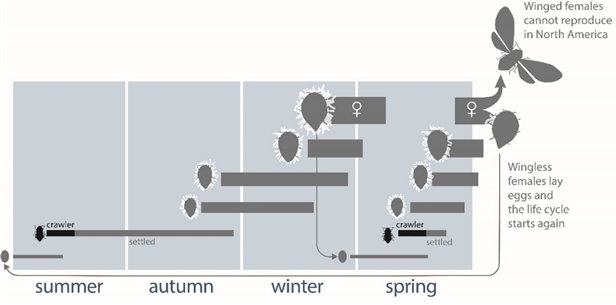
Figure 1. Hemlock woolly adelgid lifecycle. The HWA has two overlapping generations per year, known as the overwintering “sistens generation” (present from July to April) and the short-lived spring “progrediens” generation (present from April to June). Image credit: Vincent D’Amico and Nathan Havill, USDA Forest Service.
The HWA is prolific and is particularly difficult to control because of its complex lifecycle. The HWA reproduces parthenogenically in eastern North America, due to the absence of its primary host species, the tigertail spruce (Picea torano).5,6 The HWA has two overlapping generations per year (figure 1). Each female can produce up to 175 eggs (figure 2). The first stage, called “crawlers”, is HWA’s only mobile stage. Crawlers can easily be dispersed by wind, wildlife, or human activity (figure 3). Immediately after hatching, crawlers locate a feeding site at the base of a hemlock needle and insert their straw-like mouthparts. The HWA remains attached to this feeding site for the remainder of its life while surrounding itself with a protective white woolly material as it matures. Eggs are laid inside this white woolly material, which provides protection from predators and desiccation. The overwintering generation (sistens) settles into a period of dormancy after locating a feeding site (figure 4) and resumes development a few months later. The shorter spring generation (progrediens) does not experience a dormant period and completes the lifecycle by June. Both generations progress through four nymphal stages and darken in color as they mature (figure 5).7,8
Impact
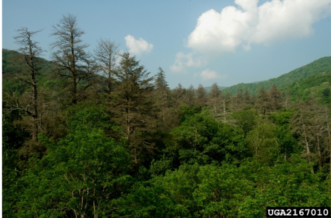
Figure 6. Decline and mortality of eastern hemlock caused by HWA. Image credit: William M. Ciesla, Forest Health Management International, Bugwood.org.
The HWA uses its long, straw-like mouthparts to feed on fluids stored in the xylem cells at the needle base where they settled. This impedes the tree’s nutrient uptake, which causes decline in new growth and may cause tree death in as few as two to four years after the initial infestation.9 Mature trees can die in four to ten years depending on the level of HWA infestation, tree size, level of environmental stress, and quality of the growing site (figure 6). Visible symptoms of HWA infestation are yellowing needles, branch death, and canopy thinning.10 The loss of a foundation species like eastern hemlock can have devastating effects on ecological functions and forest biodiversity. A foundation species is essential to the structure of a habitat. Specifically, hemlocks provide essential shade to native hardwood and conifer species; influence stream temperatures and nutrient cycling; and provide habitat and shade for wildlife.4,11 Additionally, hemlock mortality in developed areas is a threat to public safety due to falling dead trees, tree removal costs, and reduced property value.8
Identification
Before selecting an appropriate method of control, make sure HWA is present and determine the severity of the infestation. A representative from your state forestry commission or your local university extension service can assist with the identification process. Monitoring for HWA can make a difference, and early detection of infestations can improve chances of control and even eradication. Hemlock trees have small, flat needles with a conspicuous white stripe on the underside of the needle (figure 7). To best see HWA’s characteristic white wool, turn the branch upside down. There will be small woolly cotton-like balls at the base of the needle where the needle meets the twig (figure 8). If the tree is heavily infested, the white wool can be seen from the ground (figure 9).
Management
Chemical Control
Choosing the right management approach is dependent on the location, acreage, setting, level of infestation, and site goals. Broad-spectrum contact insecticides are toxic to insects upon direct contact. Contact insecticides provide fast HWA mortality, have short-term effects, and are a good management option for single trees and hedgerows in small-scale urban or nursery environments. These insecticides include horticultural oils, organophosphates, carbamates, pyrethroids, and avermectins (table 1).12 When applying contact insecticides, the entire canopy of the infested tree must be coated with a foliar spray. Applications must occur twice a year, while crawlers are still mobile and before the insect is protected by a layer of white, waxy wool. Caution should be used, as these products may drift when sprayed, will kill most insects present (including beneficial species), and have a higher toxicity to vertebrates than systemic insecticides.8 If the infestation is localized, pruning can be an effective form of control.10
Systemic insecticides are absorbed by the plant after application and are toxic to the target insect when they feed on the plant material. Systemic insecticides can be used to treat target trees in both developed and forested landscape settings. Systemic insecticides are applied to the soil or tree trunk through a variety of methods, including soil drench, soil injection, trunk injection, trunk spray, or slow release tablets. The insecticide is absorbed by the tree through roots or bark penetration and moves up into the canopy where HWA feeds.13 The most common systemic insecticides used for HWA suppression are imidacloprid and dinotefuran. Imidacloprid takes about three months to be effective, but residual control can last up to seven years.14,15 Dinotefuran can become effective in about a month’s time but control only lasts up to two years.16 Dinotefuran is effectively used to reduce heavy HWA infestations quickly and can be combined with imidacloprid for a longer residual effect in heavily infested trees.17 It is optimal to apply systemic insecticides in the spring after the ground has thawed, when the tree is actively growing and moving water and nutrients into the canopy. However, treatment timing and formulation recommendations are variable. Always check with your local state foresters on best management practices. Always read the label carefully before use of any pesticide. When using systemic insecticides, horticultural oils and insecticidal soaps should be supplemented periodically to slow the development of pesticide resistance in HWA.
Biological Control
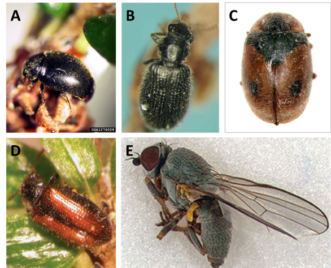
Figure 10. HWA biological control agents: (A) Sasajiscymnus tsugae (Image credit: Carole Cheah, Connecticut Agricultural Experiment Station, Bugwood.org); (B) Laricobius nigrinus (Image credit: Ashley Lamb, Virginia Polytechnic Institute and State University, Bugwood.org); (C) Scymnus sinuanodulus (Image credit: Pennsylvania Department of Conservation and Natural Resources – Forestry, Bugwood.org); (D) Laricobius osakensis (Image credit: Ligia C. Viera, Virginia Tech); (E) Leucopis sp. (Image credit: Nathan Havill, USDA Forest Service Northern Research Station.
Biological control is a method of reducing or mitigating pests with natural enemies (e.g., predators, parasites). Several natural enemies of HWA have been identified throughout its native range of Asia and western North America and are approved for release in the eastern United States. These predator insects include Sasajiscymnus tsugae, Laricobius nigrinus, Scymnus sinuanodulus, and Laricobius osakensis.18 Two Leucopis fly species are currently being reviewed by researchers at Oregon State University as potential biological control agents. The establishment of these predator populations and their impact on HWA infestations and hemlock health continue to be under investigation (figure 10).19 Biological control methods alone will never eliminate HWA populations, but biological controls can help to slow the spread of populations when combined with other management strategies. Integrating biological control into your management plan can facilitate long-term, large-scale outcomes through the establishment of a natural ecological balance and prevent environmental damage associated with sole use of chemical control methods. When successful, biological control agents will be self-sustaining and eventually spread throughout the HWA population. However, it can take years, or even decades before a pest population is controlled through the introduction of natural enemies. Biological control insects are currently only being released on conserved public lands in partnership with state and regional collaborators and cannot be sold to private landowners at this time.
Conclusion
The introduction of HWA has permanently altered forests in eastern North America. Hemlock loss will have negative ecological consequences, and it is important to take steps to suppress HWA and preserve hemlocks where possible. For landowners, treating the infested tree is usually the more economical option and costs less than removing a dead tree that has become a safety hazard. Single specimen or ornamental trees in the landscape can be treated effectively with horticultural oil, contact insecticides, and systemic insecticides. Contact insecticides are not practical in a forest ecosystem and can have negative effects on the environment when applied through foliar sprays. Careful application of systemic insecticides and use of biological control agents are currently the best management tactic for hemlocks infested with HWA in natural or forested areas.
Table 1. Chemical control options for the suppression of HWA populations in developed and forested landscapes.
| Chemical Control | Chemical Family | Active Ingredients | Trade NameA | Application MethodB | Target
Life Stage |
Site TypeC |
| Contact Insecticides | Oils | Horticultural Oil | Ultra-Pure Oil | Foliar spray | All | Developed |
| Insecticidal Soap | M-Pede | Foliar spray | All | Developed | ||
| Organophosphate | Chlorpyrifos | Dursban 50W | Foliar spray | Crawlers | Developed | |
| Carbamate | Carbaryl | Sevin SL
Sevin T&O |
Foliar spray | Crawlers | Developed | |
| Pyrethroid | Bifenthrin | OnyxPro | Foliar spray | Crawlers | Developed | |
| Pyrethroid | Tau-fluvalinate | Mavrik Aquaflow | Foliar spray | Crawlers | Developed | |
| Neonicotinoid | Acetamiprid | TriStar 8.5 SL | Foliar spray
Basal bark spray |
Crawlers | Developed | |
| Azadirachtin | Azadirachtin | Azatin O | Foliar spray | Crawlers | Developed | |
| Systemic Insecticides | Avermectin | Abamectin | Aracinate TM | Tree injection | Adults & nymphs | Developed
Forested |
| Organophosphate | Oxydemeton methyl | Harpoon
MSR Spray Conc. |
Foliar spray
Bark basal spray |
Adults & nymphs | Developed
Forested |
|
| Contact + Systemic InsecticidesD | Pyrethroid + Neonicotinoid | Bifenthrin + clothianidin | Aloft LC, G, LC, SC | Foliar spray
Soil Injection |
Crawlers
Adults & nymphs |
Developed |
| Pyrethroid + Neonicotinoid | Bifenthrin + imidacloprid | Allectus SC | Foliar spray
Soil Injection |
Crawlers
Adults & nymphs |
Developed | |
| Pyrethroid + Neonicotinoid | Cyfluthrin + imidacloprid | Discus N/G | Foliar spray
Soil drench |
Crawlers
Adults & nymphs |
Developed | |
| Pyrethroid + Neonicotinoid | Lambda-cyhalothrin + thiamethoxam | Tandem | Foliar spray
Soil drench |
Crawlers
Adults & nymphs |
Developed | |
| Pyrethroids + Neonicotinoid | Zeta-cypermethrin + bifenthrin + imidacloprid | Triple Crown T&O | Foliar spray
Soil drench |
Crawlers
Adults & nymphs |
Developed | |
| Neonicotinoid | Dinotefuran | Safari 2G, 20 SG
Zylam Liquid |
Basal bark spray | Adults & nymphs | Developed Forested | |
| Transect 70 | Foliar spray
Soil injection Soil drench Basal bark spray |
Crawlers
Adults & nymphs |
||||
| Neonicotinoid | Imidacloprid | Xytect 75 WSP, 2F | Foliar spray
Basal bark spray |
Crawlers
Adults & nymphs |
Developed Forested | |
| Marathon II, 60WP | Foliar spray
Soil injection Soil drench |
|||||
| Merit | ||||||
| CoreTect | Slow release tablets | |||||
| Discus Tablets | ||||||
| Neonicotinoid | Thiamethoxam | Flagship 25 WG | Foliar spray | Crawlers
Adults & nymphs |
Developed | |
| Meridian 0.33G; 25 WG | Basal bark spray | |||||
| Tetronic /Tetramic
acid derivative |
Spirotetramat | Kontos | Foliar spray
Soil drench |
Crawlers
Adults & nymphs |
Developed | |
| Diamide | Chlorantraniliprole | Acelepryn | Soil injection | Adults & nymphs | Developed |
Adapted from Southeastern U.S. Pest Control Guide for Nursery Crops and Landscape Plantings.8,20
Note: A Trade names are provided as examples only. Check product labels for current restrictions and use requirements. B Application methods sourced from the product labels. Methodology varies between products and can only be carried out by certified pesticide applicators. C “Developed” site types include nurseries, greenhouses, gardens, urban, and suburban landscapes. Recommended site types vary between products, always check product labels for up-to-date use requirements. D For products used as contact and systemic insecticides, foliar spray should be applied to target HWA crawler stage, systemic applications should be made to target developing nymphs and adults that are actively feeding. For specific information about development stages, associated damage, and action thresholds to properly time applications, consult with your state cooperative extension service.
References Cited
- Havill N, Shiyake S, Galloway A, Footitt R,Yu G, Paradis A, Elkinton J, Montgomery M, Sano M, Caccone A. Ancient and modern colonization of North America by hemlock woolly adelgid (Hemiptera: Adelgidae), an invasive insect from East Asia. Mol Ecol. 2016; 25(9):2065-2080.
- Souto D, Luther T, Chianese B. Past and current status of HWA in eastern and Carolina hemlock stands. Onken B, Reardon R, editors. Charlottesville (VA): USDA Forest Service; 1996.
- Orwig D, Foster D, Mausel D. Landscape patterns of hemlock decline in New England due to the introduced hemlock woolly adelgid. J Biogeogr. 2002; 29(10-11):1475-1487.
- Mayfield A, Reynolds B, Coots C, Havill N, Brownie C, Tait A, Hanula J, Joseph S, Galloway A. Establishment, hybridization and impact of Laricobius predators on insecticide-treated hemlocks: exploring integrated management of the hemlock woolly adelgid. For Ecol Manage. 2015; 335:1–10.
- Young R, Sheilds K, Berlyn G. Hemlock woolly adelgid (Homoptera: Adelgidae): Stylet bundle insertion and feeding sites. Ann Entomol Soc Am. 1995; 88: 827-35.
- Letheren A, Hill S, Salie J, Parkman J, Chen J. A little bug with a big bite: Impact of hemlock woolly adelgid infestations on forest ecosystems in the eastern USA and potential control strategies. Int J Environ Res Public Health. 2017; 14(4):438.
- Havill N, Footitt R. Biology and evolution of Adelgidae. Annu Rev Entomol. 2007; 52:325-349.
- McCarty E, Addesso K. Hemlock woolly adelgid (Hemiptera: Adelgidae) management in forest, landscape, and nursery production. J Insect Sci. 2019; 19(2):1-17.
- Orwig D, Foster D. Forest response to the introduced hemlock woolly adelgid in southern New England, USA. J Torrey Bot Soc. 1998; 125(1):60-73.
- Addesso K, Benton E, Oliver J. 2018. Hemlock woolly adelgid management and quarantine regulations impacting nursery production [Internet]. Tennessee State Cooperative Extension and University of Georgia Warnell Outreach Publication. 2018; [accessed 2019 May 16];AR-ENT-01-2018, WSFNR-18-46. http://www.tnstate.edu/extension/documents/Hemlock%20Woolly%20Adelgid%20Management%20Quarantine%20Nursery.pdf.
- Dharmadi S, Elliott K, Miniat C. Lack of forest tree seedling recruitment and enhanced tree and shrub growth characterizes post-Tsuga canadensis mortality forests in the southern Appalachians. For Ecol Manage. 2019; 440:122-130.
- McCarty E, Wiggins G, Coyle D. Biology and management of the hemlock woolly adelgid in the eastern U.S [Internet]. Southern Regional Extension Forestry – Foresty Health. 2019; [accessed 3 June 2019]. http://southernforesthealth.net/insects/hemlock-woolly-adelgid/publication.2019-05-15.3518212058/view.
- Cowles R, Montgomery M, Cheah C. Activity and residues of imidacloprid applied to soil and tree trunks to control hemlock woolly adelgid (Hemiptera: Adelgidae) in forests. J Econ Entomol. 2006; 99(4):1258-1267.
- Benton E, Grant J, Webster R, Nichols R, Cowles R, Lagalante A, Coots C. Assessment of imidacloprid and its metabolites in foliage of eastern hemlock multiple years following treatment for hemlock woolly adelgid, Adelges tsugae (Hemiptera: Adelgidae), in forested conditions. J Econ Entomol. 2015; 108(6):2672-2682.
- Coots C, Lambdin P, Grant J, Rhea R. Spatial and temporal distribution of residues of imidacloprid and its insecticidal 5-hydroxy and olefin and metabolites in eastern hemlock (Pinales: Pinaceae) in the southern Appalachians. J Econ Entomol. 2013; 106(6):2399–2406.
- Joseph S, Braman S, Quick J, Hanula J. The range and response of neonicotinoids on hemlock woolly adelgid, Adelges tsugae (Hemiptera: Adelgidae). J Environ Hort. 2011; 29(4):197–204.
- Benton E, Cowles R. Optimized insecticide dosage for hemlock woolly adelgid control in hemlock trees [Internet]. Warnell School of Forestry and Natural Resources. 2017; [accessed 12 June 2019]. http://www.warnell.uga.edu/sites/default/files/publications/WSFNR-17-01%20Benton_0.pdf.
- Vieira L, Salom S, Montgomery M, Kok L. Field-cage evaluation of the survival, feeding and reproduction of Laricobius osakensis (Coleoptera: Derodontidae), a predator of Adelges tsugae (Hemiptera: Adelgidae). Biol Control. 2013; 66(3):195-203.
- Motely K, Havill N, Arsenault-Benoit A, Mayfield A, Ott D, Ross D, Whitmore M, Wallin K. Feeding by Leucopis argenticollis and Leucopis piniperda (Diptera: Chamaemyiidae) from the western USA on Adelges tsugae (Hemiptera: Adelgidae) in the eastern USA. Bull Entomol Res. 2017; 107(5):699-704.
- Chong J, Klingeman B, Hale F, Dale A, Frank S. 2017. Southeastern U.S. pest control guide for nursery crops and landscape plantings. Chong J, Williams-Woodward J, Neal J, and Springer M (NC): University of North Carolina Press; 2017.

